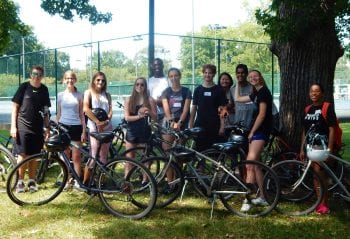During their first week of college, new students encounter many exciting firsts. In addition to experiencing first classes and on-campus activities, many students start to explore their new city through Meet St. Louis, a program that provides a unique opportunity to discover, engage, and reflect on community development efforts and service opportunities in St. Louis.
Meet St. Louis participants select their pick from a diverse range of small group experiences led by faculty, staff, and student group leaders. This year, 157 first-year students joined one of 15 excursions, taking their first step in a critical dialogue about what it means to be an engaged member of the St. Louis community. 31 excursion leaders and 19 community partners facilitated trips. At the end of each excursion, students had the opportunity to discuss what they learned and would take away from the day. This year’s program also featured a new pizza dinner to promote further discussion and reflection among the groups. Below are overviews of three excursions: a tour at a nonprofit medical clinic, an exploration of public art spaces, and a bike ride through neighborhoods with a focus on local food.
Global Brigades Tour of Casa de Salud
“Anyone interested in health care should be aware of how nonprofit clinics contribute to the ‘health safety net’ and the importance of cross cultural understanding in building a healthy and inclusive community.” – Matthew Agritelley, Class of 2018
27 students traveled to St. Louis University’s campus to visit Casa de Salud, a nonprofit community health clinic for the city’s uninsured and under-insured populations. They engaged in an interactive discussion with Casa’s Community Outreach Coordinator, focusing on obstacles to immigrant healthcare along with the nonprofit landscape in the St. Louis community. Students also had the opportunity to tour Casa’s clinical facility and administrative offices before debriefing as a group.
The excursion provided a unique opportunity to participants by enabling them to experience a healthcare space. “It was incredible to see students explore the bilingual clinical exam rooms after learning about the many services Casa offers,” said Agritelley.
Immigrant and under-served residents comprise a significant portion of the urban St. Louis population, and by touring Casa’s facilities, students developed a better understanding of the demographic layout of the community they will reside in for the next four years.
Envisioning the City: Public Art and Public Space in St. Louis
“My goal for the Meet St. Louis program was to provide a space for students to begin sharpening their observational and analytical skills in a context they may not have previously considered.” – Amy Miller, Educator at the Mildred Lane Kemper Art Museum
Accompanied by Kemper Art Museum educator Amy Miller, architectural historian Michael Allen, and WashU senior Natalie Edwards, ten students traveled downtown to read the cultural landscape of St. Louis and explore how art, architecture, and design reveal who is – and isn’t – welcome in a space. Tour stops included Union Station, the recently renovated Central Library and adjoining Lucas Park, Citygarden, and Serra Sculpture Park. Students spent the afternoon considering the complicated history of the built environment in St. Louis and its implications for current residents through a reflective discussion at the end of the excursion.
“It was exciting to see how over the course of the day the students went from passively listening to lectures and absorbing new information to actively synthesizing that information and owning their learning experience,” Miller said. “As a moderator, all I had to do was (unfortunately) cut the discussion short so we could fill out our evaluation forms and run to catch our train!”
The experience equipped students with tools for critically evaluating the built environment. They also learned that design is not neutral; there are numerous value systems at play in the creation and maintenance of the city’s architectural landscape.
Biking through Local Food Movements

“We encourage students to consider similarities and differences in the production and distribution of local food across markets, grocery stores, and restaurant environments. We also discuss issues like food access and the prevalence of food deserts in our region. It’s a fun yet eye-opening experience for students. – Jennifer Thomas, Marketing and Communications Manager at the Gephardt Institute
Eleven students joined Jennifer Thomas and Clara Steyer, Sustainability Coordinator at WashU’s Office of Sustainability, to explore alternative transportation and local food efforts in St. Louis. Participants rode bikes to the Tower Grove Farmers’ Market, traveling through Demun, Dogtown, the Hill, Shaw, the Grove, the Central West End, and Forest Park to see local restaurants and businesses and to learn about local sustainability efforts in these neighborhoods. While at the farmers market, students had the opportunity to discover local products and hear from the market manager. They then ate lunch at Seed Sprout Spoon, a local catering and event space, and learned about the neighborhood’s efforts to unify community through local food. The journey also included a stop by City Greens Market, a local grocery store focused on helping low-income residents in food deserts, and a tour of the Burning Kumquat farm on the Danforth campus.
“Students often haven’t heard of the term ‘food desert’ before,” Thomas said. “They learn about organizations that are working to reduce disparities in food access while also increasing affordability and a sense of community in the neighborhoods they serve. It’s wonderful to hear students ask for more information and opportunities to get involved as volunteers after we hear from speakers.”
By touring St. Louis on bike, students also learned about the physical layout of St. Louis and gained confidence with navigating off-campus traffic. At the end of the excursion, Thomas and Steyer provided students with neighborhood maps and a list of restaurants and sites to explore on their own.

